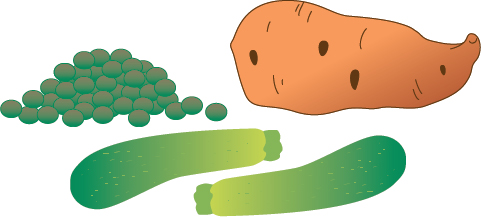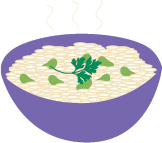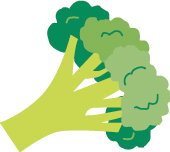
A delicious, densely nutritious meal; lentils are without doubt among the best sources of vegetable protein. The herbs and spices here fire up the digestion and are also anti-inflammatory and immune-boosting. SERVES 6




2 tsp avocado oil
1 large onion, chopped
4 garlic cloves, crushed
1 tsp ground cumin
1 tsp ground coriander
1 tsp ground turmeric
½ tsp ground cinnamon
1 tsp sweet paprika
250g sweet potatoes, peeled and chopped
100g Puy lentils
750ml vegetable stock, ideally home-made
4 large tomatoes, chopped
250g courgettes, chopped
handful of coriander, roughly chopped
2 tbsp lemon juice
1 Heat the oil in a large sauté pan or casserole dish over a medium-low heat. Fry the onion for about five minutes, until softened. Add the garlic and all the ground spices and fry for a further two minutes, until fragrant.
2 Stir in the sweet potatoes and lentils and cover with the vegetable stock. Simmer, stirring occasionally, for 20 minutes. Stir in the tomatoes and courgettes. Simmer for a further 10–15 minutes, until the lentils are tender.
3 Serve sprinkled with the coriander and lemon juice.
This tastebud sensation is a great anti-inflammatory and immune booster and is high in protein, minerals and antioxidants. I serve it at girlfriend lunches (we swoon as it cooks, the smell is so enticing), because it works for vegetarians, the gluten-free ’n’ all. SERVES 6


2 tsp coconut oil, melted
2 red peppers, sliced
250g cherry tomatoes
2 garlic cloves, crushed
1 tbsp tomato purée, or boiled-down tomatoes
1 tsp thyme leaves
½ tsp ground turmeric
½ tsp ground cumin
175g gram flour
3 large eggs
500ml almond milk
2 tbsp nutritional yeast flakes
finely grated zest of 1 unwaxed lemon
2 tbsp chopped flat-leaf parsley leaves
½ tsp chilli flakes (optional)
1 Preheat the oven to 200°C/fan 180°C/400°F/gas mark 6. Lightly oil a 23cm ovenproof dish with a little of the coconut oil.
2 Place the peppers and tomatoes in a roasting tray and drizzle over the remaining oil. Stir in the garlic, tomato purée, thyme, turmeric and cumin and roast in the oven for 15–20 minutes, until the vegetables are softened and nicely roasted. Remove from the oven and set aside.
3 Sift the flour into a mixing bowl and make a well in the centre. Crack the eggs into the well and pour in half the almond milk. Beat the mixture with a whisk until smooth, then gradually beat in the remaining milk and 150ml of filtered water to make a batter. Stir through the roasted vegetables, followed by the nutritional yeast flakes, lemon zest, parsley and chilli flakes (if using).
4 Pour the mixture into the prepared dish and bake for 20–30 minutes, until set and golden. Leave to rest for 10 minutes, then slice and serve hot or cold.
This is for people who love cooking and have time to do it! It makes an exotic, super-tasty dinner party centrepiece while still being therapeutic: anti-inflammatory, an aid to digestion and thoroughly filling. SERVES 4
FOR THE AUBERGINES
4 medium-small aubergines
2–3 tsp coconut oil, melted
1 medium onion, finely sliced
4 red peppers, sliced
2 fat garlic cloves, crushed
2 tsp cumin seeds
½ tsp ground cinnamon
½ tsp ground turmeric
pinch of Himalayan or Celtic salt
8 medium tomatoes, chopped
handful of flat-leaf parsley leaves, chopped
squeeze of lemon juice
pinch of chilli flakes (optional)
FOR THE TZATZIKI
175g goat’s or sheep’s yogurt
½ cucumber, peeled and deseeded
1 small garlic clove, crushed
2 tbsp chopped mint leaves
juice of ½ lemon, or to taste
FOR THE SPELT FLATBREADS
200g whole grain spelt flour, plus more to dust
pinch of Himalayan or Celtic salt
2 tsp dukkah, or ras el hanout
1 tsp baking powder
1 tsp avocado or coconut oil
1 To make the stuffed aubergines, preheat the oven to 220°C/fan 200°C/425°F/gas mark 7. Cut each aubergine in half lengthways. Score the cut flesh in a crisscross pattern and lay, scored-side up, on a baking tray. Drizzle the aubergines with half the oil and transfer to the hot oven for 20–30 minutes, until they are soft and burnished. Scoop most of the flesh out of the aubergines and set aside.
2 Heat the remaining oil in a large, non-stick frying pan over a medium-low heat and add the onion. Fry gently, adding a little filtered water as necessary if the onion looks as if it may catch, until softened. Add the peppers and fry for a further two minutes, then add the garlic, spices and salt. Fry for a further minute or two, until fragrant, then finally add the tomatoes and scooped-out aubergine flesh. Increase the heat and simmer for five minutes or so, until cooked through and fairly thick. Add a little filtered water to let down if necessary. Spoon the tomato mixture into the empty aubergine skins and return to the oven for five to eight minutes, until browned and bubbling hot.
3 Meanwhile, make the tzatziki and flatbreads. For the tzatziki, spoon the yogurt into a bowl and grate in the cucumber. Stir in the garlic and mint and add lemon juice to taste.
4 To make the flatbreads, sift the flour into a mixing bowl and stir in the remaining dry ingredients. Make a well in the centre and add the oil and enough warm filtered water (up to 200ml) to make a fairly stiff dough. Bring the dough together with your hands – adding a little more filtered water if necessary – and knead briefly. Divide the dough into four and roll each piece out on a lightly floured surface to a 2–4mm thickness. Heat a large, non-stick pan over a high heat and dry-fry the flatbreads one by one, until puffed up and slightly charred.
5 Serve the aubergines scattered with parsley, lemon juice and chilli flakes (if using) alongside the tzatziki and flatbreads.
This is a great youthing option for a light supper or a lazy night in. It’s tasty and low in calories. SERVES 4



1 medium cauliflower, cut into florets
2 tsp coconut oil
1 onion, finely chopped
1 small fennel bulb, roughly chopped
2 red peppers, sliced
2 garlic cloves, crushed
2 tsp sweet paprika
1 tsp ground turmeric
500ml vegetable stock, ideally home-made, plus more if needed
pinch of saffron strands
200g broad beans
handful of flat-leaf parsley leaves, roughly chopped
juice of ½ lemon
1 Pulse the cauliflower florets in a food processor until they resemble grains of rice.
2 Heat the oil in a large sauté or medium paella pan over a medium-low heat. Add the onion and gently fry, adding a little water if it begins to dry out, until softened. Add the fennel and peppers and fry for two minutes, until beginning to colour. Add the garlic, paprika and turmeric and fry for a further minute, until fragrant. Stir through the cauliflower rice until combined and pour in enough stock to cover. Sprinkle over the saffron, cover and simmer for five to eight minutes, or until the stock has been mostly absorbed and cauliflower is tender. Add more stock if necessary.
3 Tip in the broad beans and cover for a further minute or two until tender. Stir in the parsley and lemon juice and serve immediately.
Unlike shepherd’s pie (lamb) or cottage pie (beef), this vegan, dairy- and gluten-free version of the traditional dish is made from the best produce of the garden. It has a deep gravy taste you’ll love on a cold winter’s day, while the powerful nutrients in the root veg will give you energy and vigour. SERVES 6



FOR THE FILLING
½ onion, chopped
½ tsp coconut oil
1 carrot, chopped
¼ aubergine, chopped
1 garlic clove, finely chopped
3 tomatoes
2 tsp thyme leaves
1 tbsp chopped parsley leaves
pinch of caraway seeds
400g can of pinto or aduki beans, drained and rinsed
60ml vegetable stock, ideally home-made
½ tsp gluten-free miso paste
2 tsp nutritional yeast flakes
10 drops of liquid amino acids
FOR THE TOPPING
2 sweet potatoes
1 medium floury potato
1 tsp nutritional yeast flakes
10 drops of liquid amino acids
50ml vegetable stock, ideally home-made
freshly ground black pepper
1 Steam-fry the onion with a little filtered water and the coconut oil, add the carrot, aubergine and garlic and fry for two to three minutes. Reduce the heat and cook until the veg are a little soft.
2 Quarter and deseed the tomatoes and liquidise the flesh. Add half to the veg with the thyme, parsley and a good pinch of caraway. Stir gently, then add the beans, stock and miso paste. Cook slowly, stirring occasionally, for about 10 minutes. Be careful it doesn’t catch on the pan and, if you think it might, add a splash more filtered water. Now add the nutritional yeast flakes, the amino acids and the rest of the tomato. Put into a pie dish.
3 Preheat the oven to 200°C/fan 180°C/400°F/gas mark 6.
4 Now prepare the topping. Boil both types of potato together until tender, then drain and mash with the nutritional yeast flakes, amino acids and stock, seasoning with pepper. Spread the potato on top of the filling, fluff the top with a fork, then bake for 20 minutes.
NOTE
You can of course use dried pinto or aduki beans, that you have soaked and cooked yourself. When cooked, they will weigh almost double their dried weight.
This is my take on traditional family TV food, except this pizza will leave you with a spring in your step instead of a heavy, dull ache. You can change the toppings if you like but, if you are on a detox, artichoke is great for the liver and tomatoes are an antioxidant. The herbs also help with immunity and rosemary is said to improve memory. MAKES 2 LARGE PIZZAS / SERVES 4
FOR THE TOPPING
½ onion, cut into large chunks
1 garlic clove, peeled
1 tsp avocado oil
4 large tomatoes, peeled (see here), deseeded and roughly chopped
½ tsp dried oregano
pinch of Himalayan or Celtic salt
4 artichoke hearts in oil, drained and sliced
8 spring onions, sliced lengthways
2 tsp roughly chopped rosemary leaves
50g goat’s cheese (optional), crumbled or grated
FOR THE DOUGH
250g whole grain spelt flour, plus more to dust
pinch of Himalayan or Celtic salt
2 tsp baking powder
2 tsp coconut oil, melted
1 Begin by making the sauce for the topping. Place the onion and garlic in the bowl of a food processor and blitz until finely puréed. Heat the oil in a frying pan and add the onion and garlic mix. Fry gently for five minutes, until cooked through and slightly golden. Meanwhile, blitz the tomatoes in a food processor until puréed. Add the tomatoes to the cooked onion mix, with the oregano and salt. Continue to cook the mixture until thickened; this should take about five minutes. Set aside to cool.
2 Preheat the oven to 240°C/fan 220°C/475°F/gas mark 9. To make the dough, sift the flour into a mixing bowl and stir in the salt and baking powder. Make a well in the centre and pour in the oil and up to 150ml of warm filtered water to make a firm dough. Bring together with your hands, adding a little extra filtered water if necessary, and knead briefly.
3 Divide the dough into two and roll out on two lightly floured, non-stick baking sheets into large rectangles. Spoon over the sauce and spread it out over the base, then scatter the remaining toppings over the two pizzas.
4 Bake in the oven for eight to 10 minutes, until the base is burnished and the toppings are golden. Serve immediately.
Giving up meat? Hopefully the colour and texture of this veggie burger will satisfy any carnivorous cravings. Your body gets the same high quantity of iron as it would from meat (from the beetroot), plus antioxidants (from the veg) and more easily absorbable protein (from the quinoa and eggs). You can add a fried egg on top if you really feel in need of a bigger protein punch. SERVES 4


2 medium beetroots
1 large carrot
110g cooked quinoa or aduki beans
1 onion, finely chopped
2 eggs, lightly beaten
100g buckwheat flour
½ tsp fennel seeds
1 tsp coconut oil
1 Trim, peel and coarsely grate the beetroots and the carrot. Put all the ingredients except the oil into a large bowl and mix thoroughly.
2 Shape the mixture into four patties and gently steam-fry them in the oil until crispy on both sides and heated through.
Lighter than Indian fish curry, this is a nice dish for summer eating. It is very alkalising and nutrient-dense (especially if you use my vegetable stock). The spices liven up the digestion, while coconut alkalises to give a very ‘clean’ taste. You can make the base of this the night before and let the flavours mellow a bit, then heat it through, place the fish on top and steam it. SERVES 2



1–2 tsp green Thai curry paste, to taste (make your own or buy it)
1 lemon grass stalk, trimmed and thinly sliced
75ml organic coconut milk, ideally home-made
100g aubergine, chopped into cubes
3 kaffir lime leaves, shredded
2 garlic cloves, crushed
2.5cm root ginger, finely chopped or grated
¼ red pepper, thinly sliced
¼ orange pepper, thinly sliced
100g sweetcorn, shaved from the cob
150ml vegetable stock, ideally home-made
4 drops of liquid amino acids,
or a pinch of Himalayan or Celtic salt
2 pieces of white fish (haddock, monkfish, red snapper, plaice), chopped into bite-sized pieces, if you like
handful of chopped coriander
1 Fry the curry paste and lemon grass in the coconut milk until the mixture is thick and very aromatic. Add the aubergine, lime leaves, garlic and ginger, cover and simmer, but do not over-cook. Add the peppers and sweetcorn and allow to cook for a few minutes.
2 Add the stock a little at a time, keeping the thickness of the curry. Add the amino acids or salt. Simmer for a while, then place the fish on top, cover and steam until cooked. Sprinkle with coriander and serve.
Salmon is a fabulous source of protein and omega-3 fatty acids. This light meal can be served up at a dinner party and anyone suffering from joint pain, a cold or a bit of the blues will thank you as it is full of antioxidants and immune-boosting herbs, and it delivers a serotonin high. SERVES 2




FOR THE GREEN SALSA
100g spinach
100g flat-leaf parsley
100g basil
2 garlic cloves, peeled
¼ onion
1 chilli, deseeded
150ml cider vinegar
juice of 1 lemon
olive oil
FOR THE SALMON AND QUINOA
150g quinoa
500ml vegetable stock, ideally home-made
6 saffron strands
20g almonds
20g oats
4 tsp Green salsa (see above)
2 × salmon fillets
1 leek, sliced
1 tsp coconut oil
2 tomatoes, chopped
1 For the salsa, put all the ingredients except the oil in a blender and pulse-blend. Add olive oil, little by little, until it is the consistency of pesto. Preheat the oven to 200°C/fan 180°C/400°F/gas mark 6.
2 Put the quinoa, stock and saffron into a saucepan and bring to the boil. Simmer for about 10 minutes, just until the stock has almost evaporated, then turn the heat off and cover the pan. The quinoa will puff up and absorb the remaining liquid on its own. Leave it to rest.
3 Blend the almonds and oats together to make a flour. Add the oat flour to the 4 tsp of salsa and mix into a paste.
4 Remove the skin from each piece of salmon and carefully cut the fillets horizontally so each is like a sandwich. Spread the salsa mix between the pieces of salmon, as if it were the sandwich filling, reassembling each fillet afterwards. Place on a baking sheet and cook for 10 minutes.
5 Meanwhile, steam-fry the leek in a little filtered water and the coconut oil.
6 Mix the tomatoes into the warm quinoa; they will soften in the heat. Put some quinoa on each plate, place the salmon on top and sprinkle the leeks over. Serve with Grilled courgette salad with garlic and basil.
Shelled edamame (soy beans) are a fabulous way of getting fat-free protein. They taste delicious and are filling and health-enhancing. You can steam them in their pods and eat them just with a pinch of salt but, if you want a meal, here is a good option. SERVES 2




FOR THE RICE BOWLS
80g whole grain or wild rice
225g frozen edamame beans
4 radishes
½ pomegranate
30g goji berries
3 tbsp chopped coriander
10 pitted kalamata olives, halved
1 tsp mixed dried sea vegetables
¼ tsp chilli flakes
FOR THE DRESSING
1 tbsp olive oil
1 tbsp lime juice
1 Bring 300ml of filtered water to the boil and stir in the rice. Cover, reduce the heat to medium-low and simmer for 45 minutes, or until the water has almost evaporated. Turn the heat off, put a lid on the saucepan and allow it to rest.
2 Bring 400ml of filtered water to the boil, add the edamame beans and cook for about two minutes, or until tender, then drain and set aside.
3 Chop the radishes. Scoop the seeds out of the pomegranate.
4 Combine the rice, edamame, radishes, pomegranate, goji berries, coriander, olives, sea vegetables and chilli flakes in a large bowl.
5 Mix the olive oil and lime juice and gently fold into the rice.
Alkalising, anti-inflammatory, high in fibre and cholesterol-reducing, this super-easy dish is also a good detoxer, as split peas are high in molybdenum, a mineral that metabolises sulphites (preservatives) and alcohol. Plus it’s filling. Eat as a main meal or a side with curry. SERVES 4 SMALL OR 2 BIG APPETITES




200g dried split peas
1 garlic clove, crushed
½ onion, finely chopped
1 tsp coconut oil
1 tsp ground turmeric
½ tsp cayenne pepper
½ tsp chilli flakes
¼ tsp Himalayan or Celtic salt
400ml organic coconut milk, ideally home-made
1 Pour the peas into a jug and note their volume. Tip into a colander and wash well. Put in a saucepan with five times their volume of filtered water. Bring to the boil, then simmer for 35 minutes or until tender. Drain and rinse thoroughly.
2 Sauté the garlic and onion in the coconut oil until translucent. Add the spices and salt and cook for two minutes, stirring. Add the cooked split peas and coat them in the spices, then pour in the coconut milk. Simmer gently for about 20 minutes, adding a little filtered water if the mixture becomes too thick.
Good for detox and weight loss, cholesterol-reducing, inflammation-busting and antioxidant, this is youthing on a plate. It’s pretty yummy too and, if you cut and cook the courgettes right, they’ll eat just like al dente pasta. SERVES 2



2 courgettes
2 tomatoes
50g pine nuts
150ml vegetable stock, ideally home-made
20g root ginger, finely chopped
8 basil leaves
1 Wash the courgettes thoroughly and, with a peeler or a mandolin – or a spiraliser, if you have one – slice into thin slices, or, if you like a thicker feel, cut lengthways into small thick strips, like spaghetti.
2 Peel the tomatoes: make a small cross-shaped incision at the base of each, then dip in boiling water for 15 seconds or until the skin is beginning to come away from the flesh. Remove the tomatoes with a slotted spoon and plunge into ice-cold water. Carefully peel the skins away, then chop the tomatoes very finely.
3 Roast the pine nuts until lightly bronzed: place the pine nuts in a dry frying pan over a medium heat and cook, stirring, until they turn a shade darker and smell toasted. Tip out on to a plate to cool and stop the cooking.
4 Put 100ml of the stock in a saucepan with the tomatoes and ginger and simmer slowly for about five minutes, or until the stock has reduced. Add the rest of the stock and the courgettes. Simmer for a further minute and a half or until the courgettes have wilted. Tear in the basil and mix together.
5 Take off the heat and sprinkle with the pine nuts.
Indian food is an easy way to eat therapeutic, youthing spices in large quantities. What with the white fish and root veg, this is a protein- and omega-3-rich dish which tastes substantial and meaty. You can make the vegetable base of this curry the night before, then heat it through and place the fish on top to steam. This will also give a chance to let the spices mellow. SERVES 2



300ml organic coconut milk, ideally home-made
10g root ginger, finely chopped
3 tsp mild curry powder
2 tsp ground turmeric
1 tsp non-creamy horseradish (read the label!)
4 cardamom pods, crushed
1 garlic clove, crushed
3 curry leaves
2 star anise
100g aubergine, chopped
100g new potato, chopped
100g butternut squash, chopped
pinch of Himalayan or Celtic salt or mixed dried sea vegetables
2 fillets of firm white fish, cut into bite-sized pieces
4 large prawns
50g green mango, or regular mango, finely chopped
handful of chopped coriander, to serve
lime wedges, to serve
1 Pour about 50ml of the coconut milk into a hot pan and let it simmer for 90 seconds, to reduce and thicken. Add the ginger, curry powder, turmeric, horseradish, cardamom, garlic, curry leaves, star anise and a further 150ml of the coconut milk.
2 Now add the aubergine, potato and squash and let it simmer, adding small amounts of coconut milk to prevent it from getting too dry, until it has all been used up. Then start adding splashes of filtered water when needed – up to a maximum of 75ml – until it, too, is all used up. Cover and simmer for three to four minutes, then season with the salt or sea vegetables.
3 When the vegetables are cooked, place the fish and prawns on top, replace the lid and steam the fish for about two minutes. Gently stir in the mango. Serve, sprinkled with coriander, with lime wedges on the side.
One of my dinner party favourites, this is super-easy to make but looks almost Cordon Bleu. SERVES 4




2 tsp avocado or coconut oil
1 medium onion, chopped
2 garlic cloves, finely chopped
2 tsp finely chopped oregano leaves
1 red pepper, finely sliced
4 cod fillets
4 large tomatoes, deseeded, chopped
6 pitted black olives, halved
juice of ½ lemon
¼ tsp freshly ground black pepper
handful of basil leaves, shredded
1 Preheat the oven to 180°C/fan 160°C/350°F/gas mark 4.
2 Heat the oil in a large ovenproof frying pan over a medium-low heat. Add the onion, garlic and oregano and fry gently for two or three minutes, until beginning to soften. Add the pepper and fry for a further two or three minutes, until everything is soft and golden.
3 Add the cod fillets and fry for a minute on each side. Tip in the tomatoes and olives and bring to a simmer.
4 Transfer the pan to the oven and bake for 10–12 minutes, until the fish is opaque and cooked through. If you think it could do with a little more colour, pop it under a hot grill for a couple of minutes. Sprinkle with the lemon juice, season with the pepper and scatter over the basil to serve.
The aromatics here – ginger, onion, garlic and chilli – get your stomach ready for digestion. Served with Sesame broccoli this is an alkalising, anti-inflammatory meal. SERVES 4




4 × 120g white fish fillets, such as sea bass, haddock or pollack
4 spring onions, finely sliced
2.5cm root ginger, shredded
2 garlic cloves, finely sliced
2–4 bird’s eye chillies (depending how hot you like it), finely sliced
2 tsp liquid amino acids
1 tsp coconut oil, melted
Sesame broccoli, to serve
1 Preheat the oven to 180°C/fan 160°C/350°F/gas mark 4. Lay out four large sheets of baking parchment and fold them in half vertically. Draw out a half heart shape on the top piece of paper (large enough to fit one fish fillet) and cut out. Unfurl the paper to make four hearts and place a fish fillet on one side of each heart. Sprinkle the remaining ingredients between the fillets.
2 Lay the top side of each heart over the fish and, starting at the pointed end, crimp the paper at the edges to envelop the fish. Repeat with the remaining parcels and carefully transfer them all to a baking sheet, spacing them out well.
3 Bake for 10–12 minutes, until the paper is golden and the parcels have puffed up with steam. To serve, cut open each parcel to release the delicious aromas.
Squid is a light protein source that adds a delicious texture to a dish. Courgettes are high in fibre, vitamins, antioxidants, help reduce cholesterol… and make zany spaghetti! Spiced with fragrant European herbs that are good for digestion and high in vitamin D, this is tasty, wholesome and youthing. SERVES 4




1kg squid, cleaned
2 large courgettes
50ml vegetable stock, ideally home-made
2 tsp ground ginger
1 tsp coconut oil
½ tsp chopped mint leaves
½ tsp chopped basil leaves
½ tsp chopped parsley leaves
1 tsp lemon juice
1 Wash the squid, then cut off both ends of the tubes (set the tentacles aside). Cut down one side to open out the tubes, then scrape the inner surface clean with the blunt edge of a knife. Slice through to create two halves. Make crisscross score marks on the inside of the squid, being careful not to cut through. You can now either cut the squid into thin strips that will mix easily with the courgette spaghetti, or cut each into four quarters, which will curl up when cooked and sit on the top.
2 Wash the courgettes thoroughly and with a peeler or a mandolin – or a spiraliser, if you have one – slice into thin slices, or, if you like a thicker feel, cut lengthways into small thick strips, like spaghetti.
3 Simmer the courgettes in the stock and ginger; keep turning until the courgette is limp.
4 Steam-fry the squid in the coconut oil until it has curled up and is a solid white colour.
5 When the courgette and squid are ready, mix them together and sprinkle with the herbs and lemon juice.